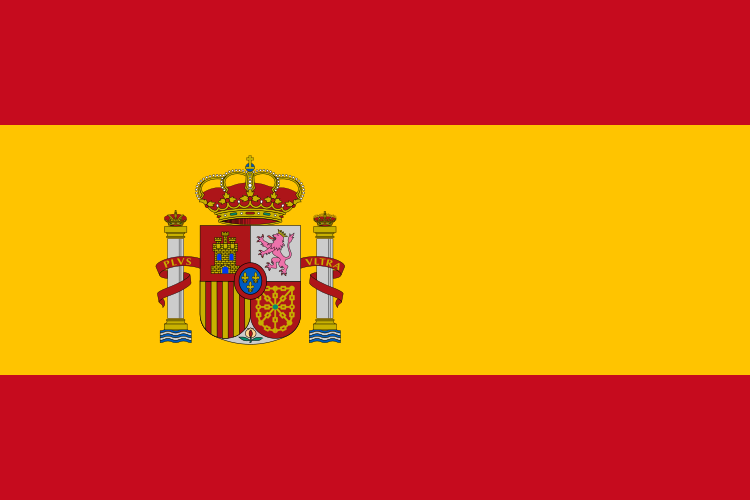Progesterone Therapy for Pregnant Mares - Part 2: The Most Common Questions
January 15, 2019
Posted by
Dr. Dave Scofield in
Mare Management
 Thank you to Dr. Pat McCue from the Equine Reproduction Laboratory for last
month’s article, Progesterone Therapy for Pregnant Mares – Part 1, in which
he reviewed the formulations and use of progesterone therapy in mares. Dr.
McCue did a yeoman’s task in outlining the formulations and principles of
therapy available to veterinarians for the suppression of estrus, pregnancy
support, and treating cases of suspected or diagnosed placentitis. However,
the maintenance of pregnancy is by far the most common area in which we
receive questions about supplementing mares with exogenous (therapeutic)
forms of progesterone.
Thank you to Dr. Pat McCue from the Equine Reproduction Laboratory for last
month’s article, Progesterone Therapy for Pregnant Mares – Part 1, in which
he reviewed the formulations and use of progesterone therapy in mares. Dr.
McCue did a yeoman’s task in outlining the formulations and principles of
therapy available to veterinarians for the suppression of estrus, pregnancy
support, and treating cases of suspected or diagnosed placentitis. However,
the maintenance of pregnancy is by far the most common area in which we
receive questions about supplementing mares with exogenous (therapeutic)
forms of progesterone.
Progesterone Therapy for Pregnant Mares - Part 1
December 06, 2018
Posted by
Dr. Dave Scofield in
Mare Management
 By far, the most discussed topic is supplementation of progesterone to pregnant mares to help them maintain a pregnancy. Many times, the questions stem from the necessity of such therapy, duration, and efficacy of supplementation. Sometimes, even with the best therapy, we fail to reach a good outcome, but the following discussion about the forms of supplementing progesterone is well worth a quick read for any breeder.
By far, the most discussed topic is supplementation of progesterone to pregnant mares to help them maintain a pregnancy. Many times, the questions stem from the necessity of such therapy, duration, and efficacy of supplementation. Sometimes, even with the best therapy, we fail to reach a good outcome, but the following discussion about the forms of supplementing progesterone is well worth a quick read for any breeder.
Care of the Newborn Foal
January 05, 2018
Posted by
Dr. Dave Scofield in
Foal and Neonate Care
 What transpires in the first 24 to 48 hours of a foal’s life is critical to his health and well-being from early life and up through weaning. As a foaling attendant there are several “milestones” to keep in mind as you watch the behavior of both the baby and the mare post-foaling. In this article we discuss the milestones they both should make within the few hours after the foal’s arrival into his new world. The care delivered, attention to detail, and respect for the nature of the horse will help set up your foal up for a healthier adolescence.
What transpires in the first 24 to 48 hours of a foal’s life is critical to his health and well-being from early life and up through weaning. As a foaling attendant there are several “milestones” to keep in mind as you watch the behavior of both the baby and the mare post-foaling. In this article we discuss the milestones they both should make within the few hours after the foal’s arrival into his new world. The care delivered, attention to detail, and respect for the nature of the horse will help set up your foal up for a healthier adolescence.
Oxytocin Use in the Mare
December 28, 2016
Posted by
Dr. Dave Scofield in
Mare Management
 Oxytocin is one of the most utilized hormones in broodmare practice. With so many possible clinical applications, a review of the use of oxytocin in the mare highlights the benefits of oxytocin, as well as necessary precautions with its use. Oxytocin is a nine-amino acid neuropeptide that is produced in the hypothalamus and released by hypothalamic neurons that terminate in the posterior pituitary. It is released in a natural pulsatile manner and exerts its effects by coupling with oxytocin receptors on various tissues such as the endometrium, myometrium, heart, kidney, pancreas, and fat tissue. There are also local effects of oxytocin and receptor binding, notably in the utero-placental tissues that help to increase the effect and intensity of pituitary derived oxytocin pulses. Clinically, oxytocin is available as a sterile injection, 20 IU (international units) per milliter. It can be administered intravenously or intramuscularly.
Oxytocin is one of the most utilized hormones in broodmare practice. With so many possible clinical applications, a review of the use of oxytocin in the mare highlights the benefits of oxytocin, as well as necessary precautions with its use. Oxytocin is a nine-amino acid neuropeptide that is produced in the hypothalamus and released by hypothalamic neurons that terminate in the posterior pituitary. It is released in a natural pulsatile manner and exerts its effects by coupling with oxytocin receptors on various tissues such as the endometrium, myometrium, heart, kidney, pancreas, and fat tissue. There are also local effects of oxytocin and receptor binding, notably in the utero-placental tissues that help to increase the effect and intensity of pituitary derived oxytocin pulses. Clinically, oxytocin is available as a sterile injection, 20 IU (international units) per milliter. It can be administered intravenously or intramuscularly.
How to Manage the 'Slow' Stallion in the Breeding Shed
April 28, 2016
Posted by
Dr. Dave Scofield in
Stallion Management
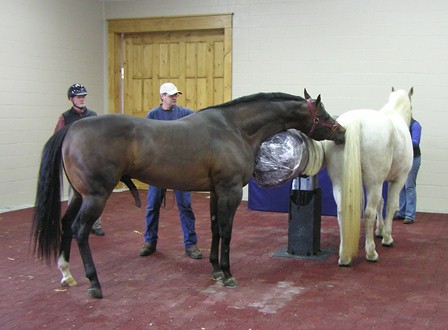 Juvenile and older males entering a new career as a breeding stallion don't have the luxury of a changing cascade of hormones or an event like parturition to jumpstart their innate nature to show them how to be a stallion. There is likely only a change in routine, location, or in their training schedule that cues them into their new roles as breeding animals. Many stallions make the transition seamlessly. Simply acting on the behavior they have been trying to use for years, allowing their behavior to mimic their springtime rise in testosterone. When exposed to a female, they have little doubt about the job at hand and will readily take to live cover or phantom training. Additional information for training the young stallion for collection can be found in our article, Collecting Semen from the Young Stallion. However, for some, the transition proves far more difficult and oftentimes frustrating for the stallion and for the staff at the shed.
Juvenile and older males entering a new career as a breeding stallion don't have the luxury of a changing cascade of hormones or an event like parturition to jumpstart their innate nature to show them how to be a stallion. There is likely only a change in routine, location, or in their training schedule that cues them into their new roles as breeding animals. Many stallions make the transition seamlessly. Simply acting on the behavior they have been trying to use for years, allowing their behavior to mimic their springtime rise in testosterone. When exposed to a female, they have little doubt about the job at hand and will readily take to live cover or phantom training. Additional information for training the young stallion for collection can be found in our article, Collecting Semen from the Young Stallion. However, for some, the transition proves far more difficult and oftentimes frustrating for the stallion and for the staff at the shed.
How to Prepare the Older Mare for Breeding Season
October 30, 2015
Posted by
Dr. Dave Scofield in
Mare Management
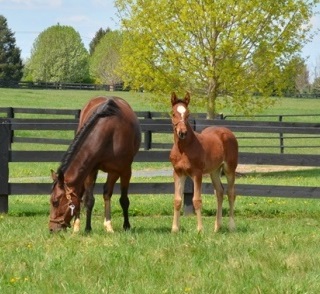 Older mares have a knack for being the sweetest and gentlest mares on the farm. We see them year after year, either carrying their own foals or returning to donate embryos if their reproductive status requires. Oftentimes, these mares are considered “special” patients, requiring a unique combination of diet, exercise, and metabolic support to maintain their physical and reproductive health. We often see older performance mares that are being bred for the first time following a long and successful show career. Reproductive problems such as cervical adhesions and uterine infection can be common in older mares which affect their ability to carry a foal or donate an embryo.
Older mares have a knack for being the sweetest and gentlest mares on the farm. We see them year after year, either carrying their own foals or returning to donate embryos if their reproductive status requires. Oftentimes, these mares are considered “special” patients, requiring a unique combination of diet, exercise, and metabolic support to maintain their physical and reproductive health. We often see older performance mares that are being bred for the first time following a long and successful show career. Reproductive problems such as cervical adhesions and uterine infection can be common in older mares which affect their ability to carry a foal or donate an embryo.
Cryopreservation of Equine Embryos
January 30, 2015
Posted by
Dr. Dave Scofield in
Embryo Transfer
Embryo vitrification doesn't sound much like "freezing embryos,” but the end product certainly is a cryopreserved equine embryo, frozen in liquid nitrogen for the preservation of genetics and transfer into a recipient mare at a later time. For the sake of some readers of this blog, an embryo is the result of fertilizing an oocyte (egg) with sperm and allowing the initial stages of development to occur. Embryo vitrification is the process whereby we freeze equine embryos for storage for indefinite periods of time prior to transfer into a recipient mare. We have the technology to cryopreserve equine sperm and equine embryos, but not equine oocytes. Herein lays the answer to the most common question that comes up in conversation regarding this blog topic. Some readers assume that since we can freeze the male generated sperm, we can likewise freeze the female generated oocyte. Unfortunately, due to some very sensitive cytoskeletal components in the oocyte, the technology does not exist to freeze equine oocytes. As we proceed, you will understand the process of embryo vitrification and we will delve into areas of research that are improving the success rates of vitrified embryos in generating live foals.
Colic in the Broodmare
September 08, 2014
Posted by
Dr. Dave Scofield in
Mare Management
 Colic is usually a word that brings to mind fussy sick newborn children, sleepless nights, and sleep-deprived parents, unless you are a horse owner. Many horse owners live in fear of finding their horses in an episode of colic. Fortunately, many bouts of gastro-intestinal pain are mild, easily treated, or easily managed on the farm or with a visit from your veterinary professional. More serious episodes could be much more in depth, require extended medical therapy and possibly abdominal surgery. No episode of colic should be taken lightly and often times, intervention by your veterinary team can help prevent escalation of the pain and disease in the horse. In cases of serious colic, swift intervention can positively affect the outcome of prolonged hospitalization or surgical repair.
Colic is usually a word that brings to mind fussy sick newborn children, sleepless nights, and sleep-deprived parents, unless you are a horse owner. Many horse owners live in fear of finding their horses in an episode of colic. Fortunately, many bouts of gastro-intestinal pain are mild, easily treated, or easily managed on the farm or with a visit from your veterinary professional. More serious episodes could be much more in depth, require extended medical therapy and possibly abdominal surgery. No episode of colic should be taken lightly and often times, intervention by your veterinary team can help prevent escalation of the pain and disease in the horse. In cases of serious colic, swift intervention can positively affect the outcome of prolonged hospitalization or surgical repair.
What is Short Cycling a Mare?
March 05, 2014
Posted by
Dr. Dave Scofield in
Mare Management
It seems daily that I am asked by clients to bring a mare into heat at a desired time to facilitate breeding, show schedules, stallion availability, synchronization with other mares, maximize early season breeding dates, or line up recipient mares with donor mares. For such a common request, and in fact, a common procedure, there are certain cases when knowing the nuisances of manipulating the length of diestrus in the mare can make or break the overall success of a reproductive cycle. In this blog article we review the process of short cycling mares.
Care of the Weanling Foal
October 22, 2013
Posted by
Dr. Dave Scofield in
Foal and Neonate Care
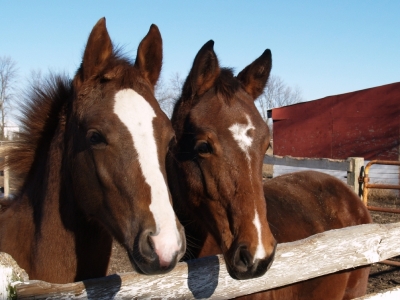 There are many milestones in the life of a foal. They start as big ones like standing, nursing, and meeting their dam for the first time. Yet as a foal ages and summer days begin to lengthen one major milestone looms over the foal…Weaning Day. From the perspective of a veterinarian, Dr. David Scofield walks us through the important aspects of weaning.
There are many milestones in the life of a foal. They start as big ones like standing, nursing, and meeting their dam for the first time. Yet as a foal ages and summer days begin to lengthen one major milestone looms over the foal…Weaning Day. From the perspective of a veterinarian, Dr. David Scofield walks us through the important aspects of weaning.
Choosing the Right Recipient Herd
April 24, 2013
Posted by
Dr. Dave Scofield in
Embryo Transfer
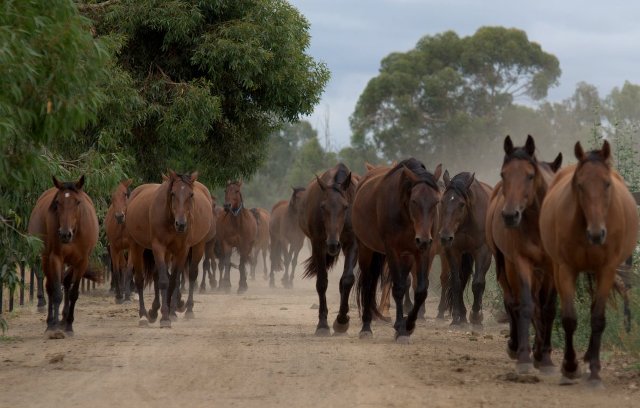 For many, the decision to perform embryo transfer (ET) from a valuable donor mare must also consider the location and availability of quality and reputable recipient mare herds. In certain parts of the country, the availability of recipient herds with fertile, healthy, manageable, and adequate recipient numbers is very limited. In other parts of the country, quality recipient herds are easily found and used successfully for both fresh and shipped embryos. Picking the right recipient herd for your donor mare should always involve carefully reading the recipient contract and knowing what is expected from the donor mare, recipient mare lease, return policy, lost embryo/fetus policy, and enrollment fee requirements. The ins-and-outs of recipient lease or purchase agreements are great topics to be covered in a later blog article. However, when it comes to selecting a recipient herd to ship your donor mare, ship a collected embryo, or trailer the donor mare into a facility for an embryo flush attempt, it is important to know what we as ET practitioners are looking for in recipient mares.
For many, the decision to perform embryo transfer (ET) from a valuable donor mare must also consider the location and availability of quality and reputable recipient mare herds. In certain parts of the country, the availability of recipient herds with fertile, healthy, manageable, and adequate recipient numbers is very limited. In other parts of the country, quality recipient herds are easily found and used successfully for both fresh and shipped embryos. Picking the right recipient herd for your donor mare should always involve carefully reading the recipient contract and knowing what is expected from the donor mare, recipient mare lease, return policy, lost embryo/fetus policy, and enrollment fee requirements. The ins-and-outs of recipient lease or purchase agreements are great topics to be covered in a later blog article. However, when it comes to selecting a recipient herd to ship your donor mare, ship a collected embryo, or trailer the donor mare into a facility for an embryo flush attempt, it is important to know what we as ET practitioners are looking for in recipient mares.
Parturition in the Mare
March 19, 2013
Posted by
Dr. Dave Scofield in
Mare Management
In our newsletter last month, we talked about getting organized and ready for foaling out your mare (click here for this news article). Being prepared for the foaling process is of paramount importance, in order to have an enjoyable and successful outcome for the mare, foal, breeders, owners, and attendants. As you are preparing your barn for the foaling, don’t forget that the mare has a chorus of events taking place internally to prepare her body for parturition, transition to lactation, and uterine involution. Whether these events are noticeable or not, they are a necessity for the proper progression of labor and delivery. In our blog article this month Dr. Scofield reviews the stages of parturition and summarizes the hormonal events that are occurring with your mare during this incredible physiological process.
Progesterone and Estrogen Therapy (P&E)
February 19, 2013
Posted by
Dr. Dave Scofield in
Mare Management
Managing the equine estrous cycle is a common procedure performed by many broodmare managers and veterinarians. Copious research has elucidated many aspects of the equine estrous cycle and allowed veterinarians the tools to manage a mare’s cycle to provide the optimal breeding times, effectively use artificial insemination, induce ovulation, synchronize mares, induce superovulation, advance the onset of the breeding season, terminate pregnancy, as well as a manage a host of other reproductive conditions and diseases. In this article we take a look at the use of progesterone and estradiol (P&E) as therapy in the mare.
How to Find a Good Equine Reproduction Veterinarian
January 23, 2013
Posted by
Dr. Dave Scofield in
Mare Management
 Owning an animal, be it a household pet, horses, or livestock can be wonderfully rewarding. There are times, however, when the responsibility of animal ownership requires the consultation of a veterinarian to ensure the health and well being of your animals or livestock. Most of these appointments will be for routine care, whereas other visits may require specialized services, like lameness diagnosis, surgery or reproductive management. Many horse owners use different veterinarians or vet clinics depending upon the services they require. However, those in more isolated or rural areas may be limited to a general practice veterinarian who routinely works with all species, being neither an equine or reproduction specialist. A breeder can still be equally successful in both situations, so long as they are prepared and have done their research to find the best veterinarian available to suit their needs.
Owning an animal, be it a household pet, horses, or livestock can be wonderfully rewarding. There are times, however, when the responsibility of animal ownership requires the consultation of a veterinarian to ensure the health and well being of your animals or livestock. Most of these appointments will be for routine care, whereas other visits may require specialized services, like lameness diagnosis, surgery or reproductive management. Many horse owners use different veterinarians or vet clinics depending upon the services they require. However, those in more isolated or rural areas may be limited to a general practice veterinarian who routinely works with all species, being neither an equine or reproduction specialist. A breeder can still be equally successful in both situations, so long as they are prepared and have done their research to find the best veterinarian available to suit their needs.
Hastening the Onset of the Breeding Season
November 20, 2012
Posted by
Dr. Dave Scofield in
Mare Management
 The horse is a seasonal breeder meaning that natural mating occurs during certain times of the year to ensure that the timing of birth is optimal for survival with regard to ambient temperature, food and water availability, and even changes in the predation behaviors of other species. Seasonal breeders are controlled by the length of daylight, i.e. the photoperiod, and can be divided into long day breeders, e.g. the horse, that start cycling when the days get longer (spring) and short day breeders, e.g. deer and some breeds of small ruminants, that start cycling when the days get shorter (fall). The length of photoperiod can be manipulated in order to hasten the onset of the breeding season. This is a popular management technique used in many breeds, so foals can be born as close to the standardized January 1st birth date as possible. It is also common with show or halter horses, with the goal being to maximize maturity for age determined competition.
The horse is a seasonal breeder meaning that natural mating occurs during certain times of the year to ensure that the timing of birth is optimal for survival with regard to ambient temperature, food and water availability, and even changes in the predation behaviors of other species. Seasonal breeders are controlled by the length of daylight, i.e. the photoperiod, and can be divided into long day breeders, e.g. the horse, that start cycling when the days get longer (spring) and short day breeders, e.g. deer and some breeds of small ruminants, that start cycling when the days get shorter (fall). The length of photoperiod can be manipulated in order to hasten the onset of the breeding season. This is a popular management technique used in many breeds, so foals can be born as close to the standardized January 1st birth date as possible. It is also common with show or halter horses, with the goal being to maximize maturity for age determined competition.
Thank you to Dr. Pat McCue from the Equine Reproduction Laboratory for last
month’s article, Progesterone Therapy for Pregnant Mares – Part 1, in which
he reviewed the formulations and use of progesterone therapy in mares. Dr.
McCue did a yeoman’s task in outlining the formulations and principles of
therapy available to veterinarians for the suppression of estrus, pregnancy
support, and treating cases of suspected or diagnosed placentitis. However,
the maintenance of pregnancy is by far the most common area in which we
receive questions about supplementing mares with exogenous (therapeutic)
forms of progesterone.
 What transpires in the first 24 to 48 hours of a foal’s life is critical to his health and well-being from early life and up through weaning. As a foaling attendant there are several “milestones” to keep in mind as you watch the behavior of both the baby and the mare post-foaling. In this article we discuss the milestones they both should make within the few hours after the foal’s arrival into his new world. The care delivered, attention to detail, and respect for the nature of the horse will help set up your foal up for a healthier adolescence.
What transpires in the first 24 to 48 hours of a foal’s life is critical to his health and well-being from early life and up through weaning. As a foaling attendant there are several “milestones” to keep in mind as you watch the behavior of both the baby and the mare post-foaling. In this article we discuss the milestones they both should make within the few hours after the foal’s arrival into his new world. The care delivered, attention to detail, and respect for the nature of the horse will help set up your foal up for a healthier adolescence. By far, the most discussed topic is supplementation of progesterone to pregnant mares to help them maintain a pregnancy. Many times, the questions stem from the necessity of such therapy, duration, and efficacy of supplementation. Sometimes, even with the best therapy, we fail to reach a good outcome, but the following discussion about the forms of supplementing progesterone is well worth a quick read for any breeder.
By far, the most discussed topic is supplementation of progesterone to pregnant mares to help them maintain a pregnancy. Many times, the questions stem from the necessity of such therapy, duration, and efficacy of supplementation. Sometimes, even with the best therapy, we fail to reach a good outcome, but the following discussion about the forms of supplementing progesterone is well worth a quick read for any breeder. Oxytocin is one of the most utilized hormones in broodmare practice. With so many possible clinical applications, a review of the use of oxytocin in the mare highlights the benefits of oxytocin, as well as necessary precautions with its use. Oxytocin is a nine-amino acid neuropeptide that is produced in the hypothalamus and released by hypothalamic neurons that terminate in the posterior pituitary. It is released in a natural pulsatile manner and exerts its effects by coupling with oxytocin receptors on various tissues such as the endometrium, myometrium, heart, kidney, pancreas, and fat tissue. There are also local effects of oxytocin and receptor binding, notably in the utero-placental tissues that help to increase the effect and intensity of pituitary derived oxytocin pulses. Clinically, oxytocin is available as a sterile injection, 20 IU (international units) per milliter. It can be administered intravenously or intramuscularly.
Oxytocin is one of the most utilized hormones in broodmare practice. With so many possible clinical applications, a review of the use of oxytocin in the mare highlights the benefits of oxytocin, as well as necessary precautions with its use. Oxytocin is a nine-amino acid neuropeptide that is produced in the hypothalamus and released by hypothalamic neurons that terminate in the posterior pituitary. It is released in a natural pulsatile manner and exerts its effects by coupling with oxytocin receptors on various tissues such as the endometrium, myometrium, heart, kidney, pancreas, and fat tissue. There are also local effects of oxytocin and receptor binding, notably in the utero-placental tissues that help to increase the effect and intensity of pituitary derived oxytocin pulses. Clinically, oxytocin is available as a sterile injection, 20 IU (international units) per milliter. It can be administered intravenously or intramuscularly.  Older mares have a knack for being the sweetest and gentlest mares on the farm. We see them year after year, either carrying their own foals or returning to donate embryos if their reproductive status requires. Oftentimes, these mares are considered “special” patients, requiring a unique combination of diet, exercise, and metabolic support to maintain their physical and reproductive health. We often see older performance mares that are being bred for the first time following a long and successful show career. Reproductive problems such as cervical adhesions and uterine infection can be common in older mares which affect their ability to carry a foal or donate an embryo.
Older mares have a knack for being the sweetest and gentlest mares on the farm. We see them year after year, either carrying their own foals or returning to donate embryos if their reproductive status requires. Oftentimes, these mares are considered “special” patients, requiring a unique combination of diet, exercise, and metabolic support to maintain their physical and reproductive health. We often see older performance mares that are being bred for the first time following a long and successful show career. Reproductive problems such as cervical adhesions and uterine infection can be common in older mares which affect their ability to carry a foal or donate an embryo.  Colic is usually a word that brings to mind fussy sick newborn children, sleepless nights, and sleep-deprived parents, unless you are a horse owner. Many horse owners live in fear of finding their horses in an episode of colic. Fortunately, many bouts of gastro-intestinal pain are mild, easily treated, or easily managed on the farm or with a visit from your veterinary professional. More serious episodes could be much more in depth, require extended medical therapy and possibly abdominal surgery. No episode of colic should be taken lightly and often times, intervention by your veterinary team can help prevent escalation of the pain and disease in the horse. In cases of serious colic, swift intervention can positively affect the outcome of prolonged hospitalization or surgical repair.
Colic is usually a word that brings to mind fussy sick newborn children, sleepless nights, and sleep-deprived parents, unless you are a horse owner. Many horse owners live in fear of finding their horses in an episode of colic. Fortunately, many bouts of gastro-intestinal pain are mild, easily treated, or easily managed on the farm or with a visit from your veterinary professional. More serious episodes could be much more in depth, require extended medical therapy and possibly abdominal surgery. No episode of colic should be taken lightly and often times, intervention by your veterinary team can help prevent escalation of the pain and disease in the horse. In cases of serious colic, swift intervention can positively affect the outcome of prolonged hospitalization or surgical repair.  There are many milestones in the life of a foal. They start as big ones like standing, nursing, and meeting their dam for the first time. Yet as a foal ages and summer days begin to lengthen one major milestone looms over the foal…Weaning Day. From the perspective of a veterinarian, Dr. David Scofield walks us through the important aspects of weaning.
There are many milestones in the life of a foal. They start as big ones like standing, nursing, and meeting their dam for the first time. Yet as a foal ages and summer days begin to lengthen one major milestone looms over the foal…Weaning Day. From the perspective of a veterinarian, Dr. David Scofield walks us through the important aspects of weaning. For many, the decision to perform embryo transfer (ET) from a valuable donor mare must also consider the location and availability of quality and reputable recipient mare herds. In certain parts of the country, the availability of recipient herds with fertile, healthy, manageable, and adequate recipient numbers is very limited. In other parts of the country, quality recipient herds are easily found and used successfully for both fresh and shipped embryos. Picking the right recipient herd for your donor mare should always involve carefully reading the recipient contract and knowing what is expected from the donor mare, recipient mare lease, return policy, lost embryo/fetus policy, and enrollment fee requirements. The ins-and-outs of recipient lease or purchase agreements are great topics to be covered in a later blog article. However, when it comes to selecting a recipient herd to ship your donor mare, ship a collected embryo, or trailer the donor mare into a facility for an embryo flush attempt, it is important to know what we as ET practitioners are looking for in recipient mares.
For many, the decision to perform embryo transfer (ET) from a valuable donor mare must also consider the location and availability of quality and reputable recipient mare herds. In certain parts of the country, the availability of recipient herds with fertile, healthy, manageable, and adequate recipient numbers is very limited. In other parts of the country, quality recipient herds are easily found and used successfully for both fresh and shipped embryos. Picking the right recipient herd for your donor mare should always involve carefully reading the recipient contract and knowing what is expected from the donor mare, recipient mare lease, return policy, lost embryo/fetus policy, and enrollment fee requirements. The ins-and-outs of recipient lease or purchase agreements are great topics to be covered in a later blog article. However, when it comes to selecting a recipient herd to ship your donor mare, ship a collected embryo, or trailer the donor mare into a facility for an embryo flush attempt, it is important to know what we as ET practitioners are looking for in recipient mares.  Owning an animal, be it a household pet, horses, or livestock can be wonderfully rewarding. There are times, however, when the responsibility of animal ownership requires the consultation of a veterinarian to ensure the health and well being of your animals or livestock. Most of these appointments will be for routine care, whereas other visits may require specialized services, like lameness diagnosis, surgery or reproductive management. Many horse owners use different veterinarians or vet clinics depending upon the services they require. However, those in more isolated or rural areas may be limited to a general practice veterinarian who routinely works with all species, being neither an equine or reproduction specialist. A breeder can still be equally successful in both situations, so long as they are prepared and have done their research to find the best veterinarian available to suit their needs.
Owning an animal, be it a household pet, horses, or livestock can be wonderfully rewarding. There are times, however, when the responsibility of animal ownership requires the consultation of a veterinarian to ensure the health and well being of your animals or livestock. Most of these appointments will be for routine care, whereas other visits may require specialized services, like lameness diagnosis, surgery or reproductive management. Many horse owners use different veterinarians or vet clinics depending upon the services they require. However, those in more isolated or rural areas may be limited to a general practice veterinarian who routinely works with all species, being neither an equine or reproduction specialist. A breeder can still be equally successful in both situations, so long as they are prepared and have done their research to find the best veterinarian available to suit their needs. The horse is a seasonal breeder meaning that natural mating occurs during certain times of the year to ensure that the timing of birth is optimal for survival with regard to ambient temperature, food and water availability, and even changes in the predation behaviors of other species. Seasonal breeders are controlled by the length of daylight, i.e. the photoperiod, and can be divided into long day breeders, e.g. the horse, that start cycling when the days get longer (spring) and short day breeders, e.g. deer and some breeds of small ruminants, that start cycling when the days get shorter (fall). The length of photoperiod can be manipulated in order to hasten the onset of the breeding season. This is a popular management technique used in many breeds, so foals can be born as close to the standardized January 1st birth date as possible. It is also common with show or halter horses, with the goal being to maximize maturity for age determined competition.
The horse is a seasonal breeder meaning that natural mating occurs during certain times of the year to ensure that the timing of birth is optimal for survival with regard to ambient temperature, food and water availability, and even changes in the predation behaviors of other species. Seasonal breeders are controlled by the length of daylight, i.e. the photoperiod, and can be divided into long day breeders, e.g. the horse, that start cycling when the days get longer (spring) and short day breeders, e.g. deer and some breeds of small ruminants, that start cycling when the days get shorter (fall). The length of photoperiod can be manipulated in order to hasten the onset of the breeding season. This is a popular management technique used in many breeds, so foals can be born as close to the standardized January 1st birth date as possible. It is also common with show or halter horses, with the goal being to maximize maturity for age determined competition.
